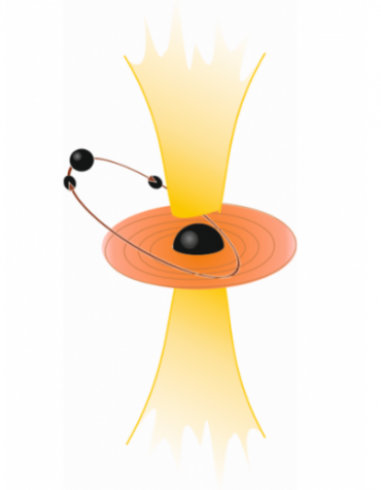Eine Erklärung geht davon aus, dass sie durch die Vereinigung zweier Galaxien entstehen. Diese durch Gravitation zusammengehaltenen Ansammlungen von Sternen, Planeten, Gas- und Staubwolken und weiteren Objekten haben neuesten Erkenntnissen zufolge im Zentrum jeweils ein Schwarzes Loch. Verschmelzen nun Galaxien, umkreisen sich aufgrund der Impulserhaltung die beiden zentralen Schwarzen Löcher der Ausgangsgalaxien noch längere Zeit, bevor sie sich vereinigen.
Um das supermassereiche Schwarze Loch (bis zu 100 Millionen Sonnenmassen) im Zentrum rotiert eine Akkretionsscheibe aus Gas, Staub und Plasma. Dieses Material stürzt in Spiralbahnen in das Schwarze Loch. Dabei wird Gravitationsenergie in Strahlungsenergie umgewandelt und abgestrahlt. Diese Abstrahlung wird durch das zweite Schwarze Loch bei dessen Umlauf periodisch gestört. Die Schwankungen in der Abstrahlung des AGN werden über einen längeren Zeitraum hinweg beobachtet. So sollen die Massen und Abstände dieser möglichen Binärsysteme Schwarzer Löcher bestimmt und somit letztlich die Existenz eines solchen Binärsystems im Zentrum dieser Galaxien nachgewiesen werden.
Wissenschaftler des Lehrstuhls für Astronomie der Universität Würzburg und des Lehrstuhls für Astroteilchenphysik Vb der Technischen Universität Dortmund erforschen aktive Galaxienkerne, indem sie die ausgesendete Gammastrahlung auf der Kanareninsel auf La Palma mit dem MAGIC-Teleskopsystem messen.
Diese Forschung wird ergänzt durch Messungen der periodischen Helligkeitsschwankungen dieser AGN im sichtbaren Spektralbereich, die Schüler an der Hans-Haffner-Sternwarte seit dem Sommer 2012 durchführen. Durch diese begleitenden Beobachtungen wird die Überwachung der AGN auf eine neue Qualitätsstufe angehoben: Über einen mehrjährigen Zeitraum entsteht ein einzigartiger Datensatz über das Langzeitverhalten der AGN im optischen Spektralbereich, der es erlaubt, durch statistische Methoden die Signaturen der Binärsysteme Schwarzer Löcher aufzuspüren und so deren Existenz zu verifizieren.





